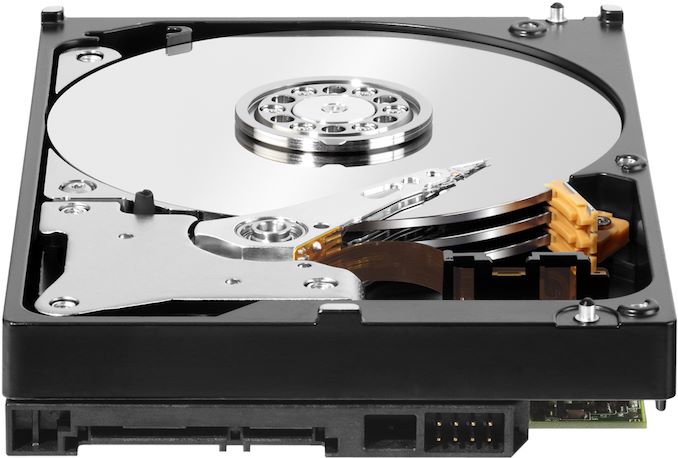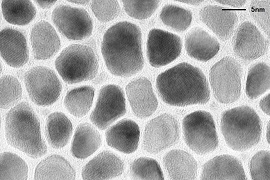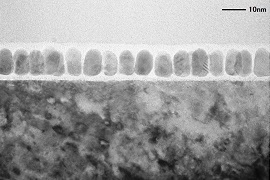The Road to 80 TB HDDs: Showa Denko Develops HAMR Platters for Hard Drives
by Anton Shilov on February 6, 2020 2:30 PM EST- Posted in
- Storage
- Seagate
- Toshiba
- Western Digital
- HAMR
- Showa Denko
- SDK
- HDD

Showa Denko K.K. (SDK) has unveiled the the company has finished the development of its next-generation heat assisted magnetic recording (HAMR) media for hard drives. The platters use all-new magnetic thin films with a very small crystal grain size in order to maximize their areal density, with the goal of eventually enabling 3.5-inch HDDs to be built with capacities of 70 TB to 80 TB.
SDK’s platters for HAMR HDDs use glass substrate and feature thin film magnetic layer made of an Fe-Pt alloy. To improve the magnetic coercivity of the media by several times over existing platters, Showa Denko used a new structure of magnetic layers and implemented new ways of controlling the temperature of the media during production.
UPDATE 2/21: As it turns out, Showa Denko will use glass substrates for platters designed for HAMD hard drives because of their superior heat resistance.
Driving these developments, it's critical to maximize the magnetic coercivity of next generation HDD platters because the crystal grains used to record data are getting extremely small. This has made them very easy to magnetize, but it has also reduced the strength of the individual magnetic signatures, which creates an unwanted magnetic inter-track interference (ITI) effect that makes it harder for HDD heads to read the data. Platters with high magnetic coercivity require energy assistance during writing and this is what energy assisted magnetic recording technologies (HAMR, MAMR, ePMR, etc.) are all about. Meanwhile, the platters must survive extreme temperatures they are subjected to during heat-assisted recording. According to Showa Denko, its new HAMR platters offer the industry’s highest read-write characteristics and durability.
Transmission Electron Microscopy Images of HAMR Media
Plain View Cross Section
SDK is not disclosing the recording density of its new platters nor are they making specific promises about when it intends to start mass production of next-generation disks. Meanwhile, the company notes that today’s leading-edge conventional magnetic recording (CMR) platters feature recording density of about 1.14 Tb/in2 and it is widely believed that this is not going to grow significantly without using energy assisted recording methods. By contrast, Showa Denko believes, HAMR-based media will achieve areal density of 5-6 Tb/in2 in the future, which will increase capacity of hard drives by several times, all the way to 70 TB – 80 TB per 3.5-inch drive without increasing the number of platters. For comparison's sake, today’s 16 TB CMR (PMR+TDMR) HDDs use nine disks, so increasing their density by ~5.2X would enable drives featuring capacities higher than 80 TB.
Showa Denko is the world’s largest independent maker of platters for hard drives, selling media to all of the HDD producers. That said, the large manufacturers — Seagate and Western Digital — also produce media themselves and tend to use their own leading-edge platters to cut costs and maximize product margins. So it will be interesting to see which of three remaining hard drive makers will be the first to use HAMR platters from Showa Denko.
Seagate will be the first company to adopt HAMR for commercial 20 TB drives in late 2020, but since Showa Denko now only plans to ‘make preparations for full-scale supply of the new HD media’, it is likely that the first HAMR drives will use Seagate’s own platters. Toshiba is expected to use Showa Denko’s 2 TB MAMR platters for its 18 TB HDDs that are projected to arrive later this year, but in the longer terms it will switch to HAMR (we have no idea when). By contrast, Western Digital uses its so-called energy-assisted PMR (ePMR) technology for its 18 TB and 20 TB HDDs due this year and will gradually move to MAMR and HAMR in the years to come.
Related Reading:
- Toshiba's HDD Tech Roadmap: A Mix of SMR, MAMR, TDMR, and HAMR
- 18 TB HDDs: Toshiba Collaborates with Showa Denko for MAMR HDDs
- HOYA Starts to Build Next-Gen HDD Glass Substrate Production Facility
- Seagate: 18 TB HDD Due in First Half 2020, 20 TB Drive to Ship in Late 2020
- Western Digital Roadmap Updates: Energy Assisted Recording, Multi-Stage Actuators, Zoned Storage
Source: Showa Denko












75 Comments
View All Comments
PeachNCream - Friday, February 7, 2020 - link
It's impressive that this particular quote still gets trotted out by people once in a while.dullard - Friday, February 7, 2020 - link
Everytime this 640K false quote comes up, I have to correct people. Bill Gates wanted 640K as the MINIMUM not the maximum. This was at a time when computers had 64K. So, Gates wanted to at a minimum have 10x the memory.azazel1024 - Friday, February 7, 2020 - link
Yup.Not that I have a strong desire to, but if my entire movie library on my server was 4k low/no compression h265 I'd go from around 2TB of data to somewhere in the range of 30-60TB.
Not that I would. Well, anytime soon. But hey, I mean if storage continues to grow, I'll find a way to use it. Pre-h.265 being "common", well common for media streamers to decode, my library was mostly 720p with just some 1080p. Now I've been ripping my BRs again at 1080p this time and I have some 4k mixed in for a handful.
If I had 2x the storage (or more), then I wouldn't have any qualms about 1080p from the get go. Probably at some point once I go from 2x3TB drives to a RAID array that is bigger, some of the stuff I have that is 1080p today, I'll probably source 4k for it (though none of this "uncompressed" stuff).
If you give me the space, I'll find a way to fill it, which will likely make my life marginally better.
olde94 - Friday, February 7, 2020 - link
Recovery would be 4 and a half day at 200mb/s and i doubt it'll be 200mb/s along the full plattervalinor89 - Friday, February 7, 2020 - link
Wouldn't the increase of density mean that at least the read speed would also increase? A modern HDD will hit at least 100mb/s average. If the density is increased 5 times the data rate (sequential) should increase similarly. (disregarding limits of SATA etc)If we maintain the rotational speed and increase the data density we will also increase the data that is read.
I have my doubts about writing, as the increased complexity might limit the speed at wich we write to the drive.
MenhirMike - Thursday, February 6, 2020 - link
With modern hard drive sizes, RAID has been a less and less appealing option. Something software-assisted that understands the file system is a better option - host-managed drives have been in use by cloud providers for a bit, and stuff like ZFS or Windows Storage Spaces also avoids the issue of "Mirror 100% of a drive when only 20% are used".mukiex - Thursday, February 6, 2020 - link
ZFS could make that mangeable. It only rebuilds the data, and you can go all triple-parity so the downtime doesn't leave you at risk of data loss.Supercell99 - Thursday, February 6, 2020 - link
Pornhub can't even use that. SSD's are the future. IOP's/GB is realBrane2 - Friday, February 7, 2020 - link
if you get 250Mb/s per head and you have 9 platters and two arms, each with 18 heads ( two heads per surface), that would get you 18x0,25=4,5GB/s.Which means less than 40.000 seconds to read and write whole 80TB.
Which is 12-ish hours.
So what ?
Valantar - Friday, February 7, 2020 - link
Yeah, sure, let's just assume that HDD R/W speeds will multiply by 20x in the next few years when they've increased by <2x over the past decade. Makes sense.